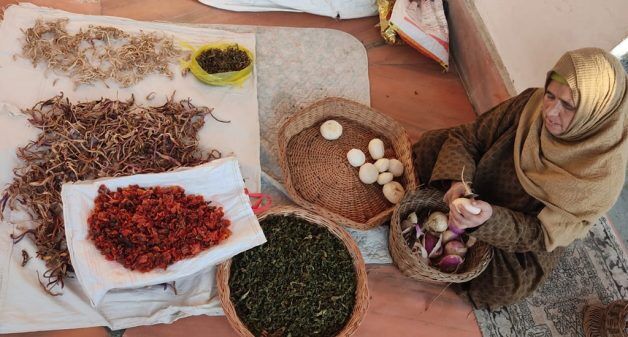What is hokh syun?
Every winter a distinct aroma fills the air of kitchens across Kashmir.
The fruits and vegetables of summer that have been carefully sun-dried and stored for months are soaked in hot water until they swell up.
They are then sautéed in oil and masalas creating an aroma that smells like winter comfort to most Kashmiris.
This dried produce – called hokh syun in local parlance – is a unique culinary tradition that is standing the test of time despite widening palates and modern supply chains.
Amidst the ongoing chillai kalan – the harshest part of winter that brings on extremely low and sub-zero temperatures – urban as well as rural kitchens in Kashmir are cooking up dishes like gogje paneer, alhache chicken and hoggad chutney made using hokh syun.
It is a boon for the famers too.
How Kashmiri farmers profit from sun-dried vegetables
Misra Bano, a 53-year-old from the Dachnipora hamlet in south Kashmir’s Anantnag district, carefully segregates her dried brinjal from the long strips of dried gourd before handing them over to the local vegetable dealer.
He weighs the sun-dried vegetables in a hand-held balance, the two then begin to negotiate a price.
Every year Bano sun-dries the surplus produce from her vegetable garden. She and her family eat some and sell the rest during winter.

“I’ve been making alhache and wangan hache (driedbottle gourd andbrinjal) for many years now. I get a good amount selling them, as there’s always demand for these dried vegetables during winter,” she said while untangling thin strips of dried bottle gourd.
About 90 kilometres away, in Ompora in the Budgam district of central Kashmir, a dozen transparent bags filled with dried vegetables can be seen in the attic window of many homes, like Dilshada Akhter’s.
Akhter also produces hokh syun as she feels it is more profitable than selling the fresh produce in summer.
“Since the price is much less due to the abundant supply in summer, I prefer to sun-dry my surplus vegetables and sell them during winter for a good return,” said Akhter.
Be it a slice of brinjal, a strip of gourd, a tomato chip, a turnip slice or local fish – their sun-dried form is part of the winter cuisine in almost every Kashmiri household.
Sun-dried vegetables: An ancient necessity in Kashmir
Consumption of hokh syun has been a part of Kashmir’s culture for decades, if not centuries, given the state’s geographic location and climatic conditions. With the fear of famine deep, hokh syun was seen as a necessity.
“In olden times harsh winters severely restricted people’s movement. They preferred to stay indoors,” said Mohammad Ashraf, a former history professor. “As there wasn’t any agricultural activity due to the severe cold, people had to dry vegetables and stock them to survive the winter.”

And it is a tradition that continues – despite the availability of fresh produce around the year in recent times – as the taste of hokh syun makes it an integral part of Kashmiri kitchens.
“I don’t eat much at this age, but I ask my children for hokh syun varieties for their aroma and taste,” said Rehmat Bibi, an octogenarian.
An agricultural surplus leads to sun-drying vegetables
During July and August, there is a large amount of gourd, tomato, brinjal and many other vegetables available, thanks to the growing trend of kitchen gardens and the availability of seeds of hybrid varieties with increased yield. Drying the uneaten produce is just common sense to many Kashmiris.
“Families and farmers usually sun-dry the surplus produce for winter use,” said Ajaz Hussain, an agricultural officer from the Jammu and Kashmir Agricultural Department. “It’s not only turnip, gourd, tomato and brinjal which are sun dried, but also others including lotus stem, fish, pepper, spinach and dandelion.”
While most of the vegetables are available throughout the year nowadays, there is still some fresh produce, like gourd and pear, which are not easily available in the valley during winters and only sold in their dried form.
Early winters increasing the demand for hokh syun
As the valley experiences early winters, with some parts receiving snowfall as early as the latter half of October, the continuous sub-zero temperatures have spurred the demand for hokh syun in the markets of Kashmir.
Those who sell these dried delicacies dot almost every major market in the state’s towns and cities in order to keep up with demand.

“I’ve been selling these sun-dried vegetables during winters for many years now,” said Fayaz Ahmad, who was selling large bags of dried vegetables and fish from his push cart in Srinagar’s famous Naweut market.
“Though these are seasonal, there’s a good demand during winters,” he said while weighing dried strips of gourd for a customer.
Taste for hokh syun — sun-dried vegetables — grows beyond valley
Contrary to some opinions, hokh syun is in demand as ever, rather it has only increased.
So much so, that Kashmiris living abroad take the sun-dried vegetables with them.
“My son Mudasir Ahmad who works in Qatar takes different varieties of hokh syun with him whenever he comes home,” said Nazir Ahmad Malik of Shalimar.
Last year Fayaz Ahmad sold eight gunny bags of dried gourd and brinjal – each bag weighing about 20 kilograms. This year he has already sold more than five, when the winters are only halfway.
Bashir Ahmad Dar, a hokh syun dealer from Noorbagh area of Srinagar, concurred. “Last year there was decline in sales because of the pandemic, but this year there’s a bumper demand,” he said. Last year Dar sold only 55 bags of dried produce, but this year he has already supplied more than 70 bags.
There is demand for sun-dried vegetables from places as far away as Kargil, Leh and Jammu too.
“On an average, I send a consignment weighing hundreds of kilograms, comprising of sun-dried veggies to these places by the end of autumn every year,” said Dar.
There have been some doctors, however, who have raised concerns about the health hygiene of hokh syun and warn against buying from dubious sellers.
“When not dried properly, fungus – a source of carcinogenic aflatoxins – can develop. But if dried and cooked properly, hokh syun is quite safe to consume,” said Abdul Gani Ahangar, a former medical superintendent from the health department of Jammu and Kashmir.
Nasir Yousufi is an independent journalist based in Srinagar.








